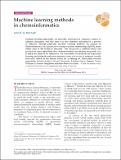Files in this item
Machine learning methods in chemoinformatics
Item metadata
| dc.contributor.author | Mitchell, J.B.O. | |
| dc.date.accessioned | 2014-03-11T15:01:01Z | |
| dc.date.available | 2014-03-11T15:01:01Z | |
| dc.date.issued | 2014-02-24 | |
| dc.identifier | 102617881 | |
| dc.identifier | 48c9f9ac-cee5-4e6a-95d3-6824ce0aeb63 | |
| dc.identifier | 84904993806 | |
| dc.identifier | 000340255600004 | |
| dc.identifier.citation | Mitchell , J B O 2014 , ' Machine learning methods in chemoinformatics ' , Wiley Interdisciplinary Reviews: Computational Molecular Science , vol. 4 , no. 5 , pp. 468–481 . https://doi.org/10.1002/wcms.1183 | en |
| dc.identifier.issn | 1759-0876 | |
| dc.identifier.other | ORCID: /0000-0002-0379-6097/work/34033393 | |
| dc.identifier.uri | https://hdl.handle.net/10023/4511 | |
| dc.description.abstract | Machine learning algorithms are generally developed in computer science or adjacent disciplines and find their way into chemical modeling by a process of diffusion. Though particular machine learning methods are popular in chemoinformatics and quantitative structure-activity relationships (QSAR), many others exist in the technical literature. This discussion is methods-based and focused on some algorithms that chemoinformatics researchers frequently use. It makes no claim to be exhaustive. We concentrate on methods for supervised learning, predicting the unknown property values of a test set of instances, usually molecules, based on the known values for a training set. Particularly relevant approaches include Artificial Neural Networks, Random Forest, Support Vector Machine, k-Nearest Neighbors and naïve Bayes classifiers. | |
| dc.format.extent | 219631 | |
| dc.language.iso | eng | |
| dc.relation.ispartof | Wiley Interdisciplinary Reviews: Computational Molecular Science | en |
| dc.subject | Machine learning | en |
| dc.subject | Quantitative structure–activity relationships (QSAR) | en |
| dc.subject | Chemoinformatics | en |
| dc.subject | Algorithm | en |
| dc.subject | Artificial Neural Networks | en |
| dc.subject | Random Forest | en |
| dc.subject | Support Vector Machine | en |
| dc.subject | k-Nearest Neighbours | en |
| dc.subject | Naïve Bayes classifiers | en |
| dc.title | Machine learning methods in chemoinformatics | en |
| dc.type | Journal article | en |
| dc.contributor.sponsor | BBSRC | en |
| dc.contributor.institution | University of St Andrews. School of Chemistry | en |
| dc.contributor.institution | University of St Andrews. Biomedical Sciences Research Complex | en |
| dc.contributor.institution | University of St Andrews. EaSTCHEM | en |
| dc.identifier.doi | 10.1002/wcms.1183 | |
| dc.description.status | Peer reviewed | en |
| dc.identifier.grantnumber | BB/I00596X/1 | en |
This item appears in the following Collection(s)
Items in the St Andrews Research Repository are protected by copyright, with all rights reserved, unless otherwise indicated.

